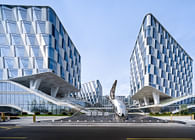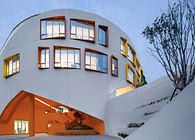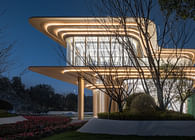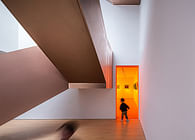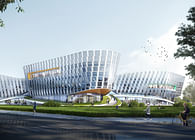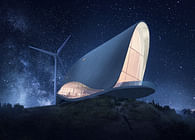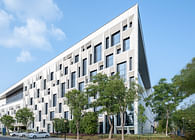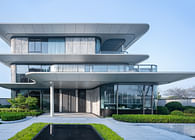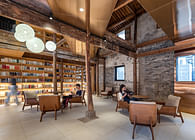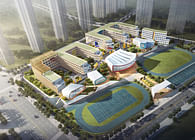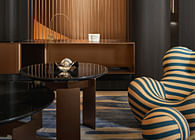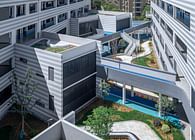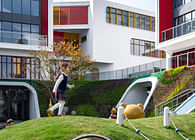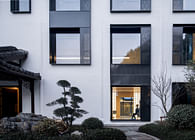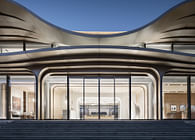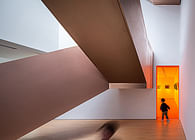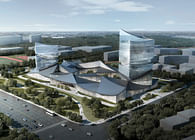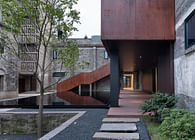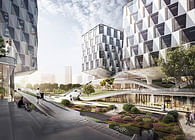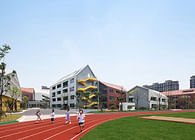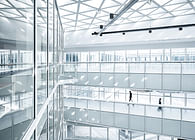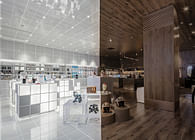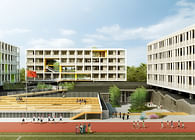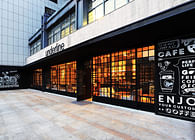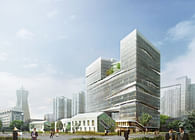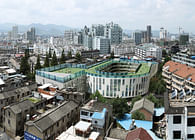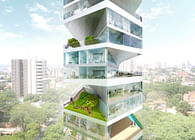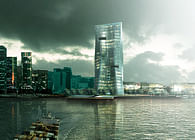
Hangzhou, CN
The Golden Heron Waves Residence is located in Keqiao, Shaoxing, adjacent to the World Heritage site of the Grand Canal. It is situated near the historically significant Taiping Bridge (listed in *The History of Science and Technology in China*) and across from the ancient Dayue Pavilion. This location perfectly combines seclusion with urban convenience. The project's planning and architectural design were executed by LYCS Architecture. The project aims to provide Shaoxing with high-end modern residential products, maximizing the scenic beauty of the Grand Canal.
**Natural Integration**
The project is divided into low-density and high-density areas, with a total construction area of 257,000 square meters. The overall layout transitions from the low-density area to the high-density area in layers. The project offers 22 types of units, ranging from 128 to 670 square meters, including garden apartments, duplex villas, townhouses, and villa-style residences. These units are carefully arranged according to various scenic locations, such as lakeside and lakeview, to maximize the views of the Grand Canal.
The project adopts a transparent design, using floor-to-ceiling glass panels that are more than twice the size of traditional glass panels. Each unit has an open or enclosed terrace, allowing residents to enjoy the magnificent natural scenery up close.
The planning design uses a classic layout strategy, with a main axis complemented by multiple secondary axes for public spaces. The main axis is composed of the entrance lobby, central landscape, and nearly 4,800 square meters of central pool landscaping, creating a ceremonial return route. This main axis is surrounded by various sanitary facilities, including children's playgrounds, a circular running track, and elevated spaces.
**Floating Elegance**
The architectural design is inspired by a walk around the site. When the architects stopped on the stone road in the southwest corner of the site, they observed the tranquil Xiaoshao Canal flowing gently and steadily. A heron gracefully skimmed the water's surface, soaring into the sky, with its dynamic curves perfectly embodying the vitality of nature. The façade design extracts elements from these figurative forms, creating broad lines that capture the distinctive features of the heron spreading its wings. This approach ultimately formed a systematic design language.
The design establishes a horizontal sequence to depict the soothing flow of a gentle stream. Continuous aluminum eaves provide shelter for the floor-to-ceiling glass, protecting it from wind, rain, and strong sunlight. This creates spaces reminiscent of traditional Chinese architecture, blurring the boundaries between indoor and outdoor spaces.
The eaves are only 45 centimeters thick, with a maximum depth of about 2,000 centimeters. By controlling the shape and size of the cantilever plates, natural light is more effectively utilized, avoiding direct sunlight. Additionally, the upper surface is designed with a slope of about 5% to aid in drainage and enhance the self-cleaning properties of the aluminum panels.
The floor plan and façade organically blend, forming an architectural shape with a rich sense of depth that reflects the distinctive features of the heron spreading its wings. In the curved transitions, unconventional double-curved aluminum panels allow lines to flow freely in multiple dimensions. This creates a façade with clear layers, evoking a beautiful and dynamic architectural aesthetic.
The design uses a large number of curved surfaces to enhance the overall sense of flowing elegance. At the corners of the buildings, oversized curved aluminum eaves complement the custom curved floor-to-ceiling glass. This not only ensures a more cohesive and smooth façade but also provides extraordinary views from the interior. Due to the high technical requirements, the production cycle for each curved glass panel is at least 20 days, with costs about 1.5 times that of standard glass of the same size.
**Architectural Expression**
The diversified product configuration results in 9 different architectural units, each undergoing dozens of design iterations to perfect its architectural expression.
The high-rise residences use champagne as the main color tone. Through the light and transparent floor-to-ceiling glass, the large continuous balconies offer expansive views, broadening the natural landscape and allowing residents to fully appreciate the surrounding natural beauty. The design team meticulously refined the curvature of the eaves, resulting in a smooth and highly dynamic sequence of curves.
The design of the stacked townhouses uses minimalist silver-white as the main color tone, continuing the design language of "curves." The overall form is simpler and purer, emphasizing the quality that remains after eliminating excessive complexity and superficial luxury. Transparent floor-to-ceiling windows and spacious terraces seamlessly integrate indoor and outdoor spaces, bringing residents infinitely closer to nature.
The villa-style residences are bordered by nature, with wrap-around courtyards enclosing the buildings, creating a private haven in the city. The design outlines the buildings with silver curves, and when viewed from above, the layered eaves resemble silver ripples on the land. The design pushes the overall concept to the extreme by integrating modernity and ecological considerations.
**Implementation Challenges**
In China, the large-scale use of non-standard materials such as oversized components and double-curved aluminum panels in residential design is relatively rare. This project posed significant challenges to the team in terms of implementation quality control and cost management.
The design team simplified the components through modular control: the glass railings, handrails, aluminum panels, and other materials were designed for seamless alignment. The spacing of the glass railings is 1.5 meters, with one glass railing corresponding to one aluminum panel, achieving standardized design. The size of the curved panels and the chamfering of the curved glass are unified, and the curved eaves are further subdivided into edge type, uphill, downhill, and curved angles for modular decomposition.
**Conclusion**
The Golden Heron Waves Residence combines the cultural and natural landscapes of the ancient city of Shaoxing with modern style, showcasing an ecological, lightweight, and comfortable lifestyle. This project represents a new exploration in Chinese residential design.
**Golden Heron Waves | Golden Heron Waves Residence**
- Location: Shaoxing, China
- Owner: Zhejiang Golden Warehouse Real Estate Group Co., Ltd.
- Area: 257,875 square meters
- Design Date: 2020/06 — 2020/09
- Construction Date: 2020/09 — 2024/01
- Planning and Architectural Design: LYCS Architecture
- Design Team: Ruan Hao, Chen Wenbin; Lin Dong, Gong Zijun, Zhang Lei, Zhang Jingjing, Zhuang Longwei, Wang Chenchen, Yan Yuechen, Lv Jun, Nie Yueyue, Tang Huiping, Huang Hao, Guo Rong, Ma Guangyu, Zhao Lin, Lao Zhedong, Liu Dongyuan, Zhang Peng, Fang Chen
- Landscape Design: NCD Studio
- Curtain Wall Design: KONSTRUCT WEST PARTNERS, CIMA
- Local Design Institute: Hangjia Design Group Co., Ltd. (Construction Drawing Design)
- Photography: Shiromio Studio, Shan-Jian Images, DONG Image, Kangren Liu
----
金仓白鹭波浪公馆位于绍兴柯桥,毗邻世界大运河文化遗产。它位于具有历史意义的太平桥(被列入<《中国科学技术史》>)和古老的大月阁对面。这个位置完美地融合了隐居和城市便利。该项目的规划和建筑设计均由LYCS Architecture执行。该项目旨在为绍兴提供高端的现代住宅产品,最大限度地利用大运河的美景。
自然渗透
项目分为低密度区和高密度区域,总建筑面积25.7万平方米,整体布局由低密度区域向高密度区域分层过渡。该项目提供22种户型,面积从128平方米到670平方米不等,包括花园洋房、复式别墅、联排别墅和别墅式住宅。这些单元根据湖滨、湖景等各种景区位置精心布置,最大限度地利用了大运河的景观。
该项目采用透明设计,利用落地玻璃板,尺寸是传统玻璃板的两倍多。每个单元都有一个开放式或封闭式露台,让居民可以近距离欣赏大自然的壮丽景色。
规划设计采用经典的布局策略,以一条主轴线为辅,为公共空间设置多个次轴线。入口大堂、中央景观、近4800平方米的中央泳池园林构成主轴线,打造仪式感十足的返乡路线。这条主轴线周围是各种卫生设施,包括儿童游乐场、环形跑道和高架空间。
飘逸的优雅
建筑设计的灵感来自在场地周围的漫步。当建筑师在场地西南角的石板路上停下来时,他们观察到宁静的小邵运河缓缓而稳定地流淌。一只白鹭优雅地掠过水面,翱翔在天空中,其动态的曲线完美地体现了大自然的生命力。立面设计从这些具象形式中提取元素,创造出宽阔的线条,捕捉了白鹭展开翅膀的独特特征。这种方法最终形成了一种系统的设计语言。
该设计建立了一个水平顺序,以描绘柔和溪流的舒缓流动。连续的铝制屋檐为落地玻璃提供庇护,保护其免受风、雨和强烈的阳光照射。这创造了让人联想到中国传统建筑的空间,模糊了内部和外部空间之间的界限。
屋檐的厚度仅为 45 厘米,最大深度约为 2000 厘米。通过控制悬臂板的形状和尺寸,可以更有效地利用自然光,避免阳光直射。此外,上表面设计有约5%的坡度,以帮助排水并增强铝板的自清洁性能。
平面图与立面的有机融合,形成具有浓郁深度感的建筑造型,映照出白鹭展翅的鲜明特征。在弯曲的过渡处,非常规的双曲面铝板允许线条在多个维度上自由流动。这创造了一个具有清晰层次的立面,唤起了美丽而动态的建筑美学。
该设计采用了大量的曲面,以增强整体的流动优雅感。在建筑的角落,超大的弧形铝制屋檐与定制的弧形落地玻璃相得益彰。这不仅确保了更具凝聚力和光滑的立面,而且还提供了从内部获得非凡的视野。由于技术要求高,每块曲面玻璃面板的生产周期至少为20天,成本约为相同尺寸标准玻璃的1.5倍。
建筑表达
多样化的产品配置造就了 9 个不同的建筑单元,每个单元都经过数十次设计迭代以完善其建筑表达。
高层住宅以香槟色为主色调。通过轻盈透明的落地玻璃,宽大的连续阳台提供了开阔的视野,拓宽了自然景观的视野,让居民充分欣赏周围的自然风光。设计团队对屋檐的曲率进行了细致的提炼,从而产生了流畅且高度动态的曲线序列。
堆叠式联排别墅的设计以极简主义的银白色为主色调,延续了“曲线”的设计语言。整体形式更加简洁纯粹,强调在消除过多的复杂性和摒弃肤浅的奢华后留下的品质。透明的落地窗和宽敞的露台将室内和室外空间无缝融合,使居民与自然无限接近。
别墅式住宅以自然为边界,环绕式庭院包裹着建筑物,在城市中创造了一个私人避风港。该设计用银色曲线勾勒出建筑物的轮廓,从上面看,分层的屋檐就像土地上的银色涟漪。该设计通过融入现代性和生态考虑,将整体概念推向了极致。
实施挑战
在国内,超大构件、双曲面铝板等非标材料在住宅设计中的大规模应用相对较少。该项目给团队在实施质量控制和成本管理方面带来了重大挑战。
设计团队通过模块化控制简化了组件:玻璃栏杆、扶手、铝板和其他材料的设计都是为了无缝对齐。玻璃栏杆的间隔为1.5米,一个玻璃栏杆对应一块铝板,实现了标准化设计。曲面板的尺寸和曲面玻璃倒角统一,弧形屋檐进一步细分为边型、上坡、下坡、曲角,进行模块化分解。
结论
金仓白鹭波浪公馆将绍兴古城的文化和自然风光与现代风格相融合,展现生态、轻盈、舒适的生活方式。该项目代表了中国住宅设计的新探索。
白鹭波浪 |金仓白鹭波浪住宅
地点:中国
绍兴 业主:浙江金仓房地产集团有限公司
面积:257,875 ㎡
设计日期:2020/06 — 2020/09
建设日期:2020/09 — 2024/01
规划及建筑设计:LYCS 建筑
设计团队:阮浩、陈文斌;林东、龚子军、张磊、张晶晶、庄龙伟、王晨辰、闫跃辰、吕军、聂月月、唐慧平、黄浩、郭蓉、马光宇、赵琳、老哲东、刘东元、张鹏、方晨
景观设计: NCD工作室
幕墙设计: KONSTRUCT WEST PARTNERS、CIMA
本地设计院: 汉佳设计集团有限公司(施工图设计)
摄影: shiromio stuido、Shan-Jian images、DONG Image、Kangren Liu
Status: Built
Location: Shaoxing, CN





